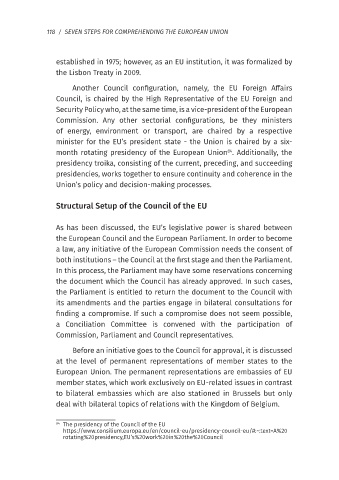Page 119 - SEVEN STEPS for COMPREHENDING the EUROPEAN UNION
P. 119
118 / SEVEN STEPS FOR COMPREHENDING THE EUROPEAN UNION
established in 1975; however, as an EU institution, it was formalized by
the Lisbon Treaty in 2009.
Another Council configuration, namely, the EU Foreign Affairs
Council, is chaired by the High Representative of the EU Foreign and
Security Policy who, at the same time, is a vice-president of the European
Commission. Any other sectorial configurations, be they ministers
of energy, environment or transport, are chaired by a respective
minister for the EU’s president state - the Union is chaired by a six-
84
month rotating presidency of the European Union . Additionally, the
presidency troika, consisting of the current, preceding, and succeeding
presidencies, works together to ensure continuity and coherence in the
Union’s policy and decision-making processes.
Structural Setup of the Council of the EU
As has been discussed, the EU’s legislative power is shared between
the European Council and the European Parliament. In order to become
a law, any initiative of the European Commission needs the consent of
both institutions – the Council at the first stage and then the Parliament.
In this process, the Parliament may have some reservations concerning
the document which the Council has already approved. In such cases,
the Parliament is entitled to return the document to the Council with
its amendments and the parties engage in bilateral consultations for
finding a compromise. If such a compromise does not seem possible,
a Conciliation Committee is convened with the participation of
Commission, Parliament and Council representatives.
Before an initiative goes to the Council for approval, it is discussed
at the level of permanent representations of member states to the
European Union. The permanent representations are embassies of EU
member states, which work exclusively on EU-related issues in contrast
to bilateral embassies which are also stationed in Brussels but only
deal with bilateral topics of relations with the Kingdom of Belgium.
84 The presidency of the Council of the EU
https://www.consilium.europa.eu/en/council-eu/presidency-council-eu/#:~:text=A%20
rotating%20presidency,EU’s%20work%20in%20the%20Council

